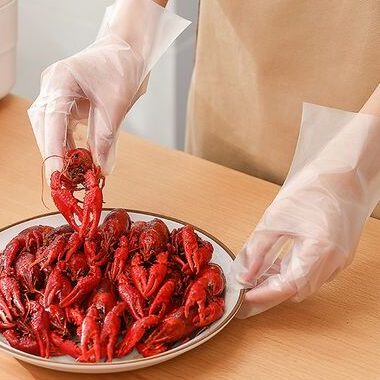ถุงมือแบบใช้แล้วทิ้งทั่วไปในการผลิตและการใช้ในชีวิตประจำวัน ได้แก่ ถุงมือ PE, TPE, PVC, ไนไตรล์ และลาเท็กซ์
ถุงมือ TPE มีคุณสมบัติทนน้ำมันได้ดีและราคาไม่แพงกว่าถุงมือ PVC จึงเหมาะกับการจัดการอาหารในร้านอาหาร
ถุงมือ PE มีราคาประหยัดและเหมาะกับการใช้งานเกี่ยวกับอาหารง่ายๆ
ถุงมือ PVC มีราคาแพงกว่าเล็กน้อยแต่มีประสิทธิภาพเหนือกว่า
ถุงมือไนไตรล์มักใช้ในทางการแพทย์ เช่น การสอบ และงานห้องปฏิบัติการ
ถุงมือลาเท็กซ์มีความยืดหยุ่นได้ดีเยี่ยมและมักใช้ในสภาพแวดล้อมทางการผ่าตัด

จะทราบได้อย่างไรว่าถุงมือแบบใช้แล้วทิ้งได้รับการรับรองความปลอดภัยด้านอาหารหรือไม่?
คำแนะนำของเฟิงหวาง:
รายงานการตรวจสอบ
ขอรายงานผลการทดสอบจากซัพพลายเออร์ ผลิตภัณฑ์ที่เป็นไปตามมาตรฐานความปลอดภัยสำหรับอาหารจะต้องเป็นไปตามข้อกำหนดเกี่ยวกับปริมาณโลหะ การเคลื่อนที่ของพลาสติไซเซอร์ ขีดจำกัดของจุลินทรีย์ ฯลฯ
ตรวจสอบฉลากและการรับรอง
มองหาการรับรองที่เกี่ยวข้อง เช่น การรับรองจาก FDA (สหรัฐอเมริกา) การอนุมัติวัสดุสัมผัสอาหารจากสหภาพยุโรป ฉลากเช่น “เกรดอาหาร” หรือ “สำหรับสัมผัสอาหาร”
วัสดุ
ตรวจสอบให้แน่ใจว่าถุงมือทำจากวัสดุที่สัมผัสอาหารที่ได้รับการรับรอง (เช่น PE, TPE, PVC)
ชื่อเสียงของผู้ผลิต
แบรนด์ที่มีชื่อเสียงและผู้ผลิตที่เป็นที่ยอมรับมักจะนำเสนอผลิตภัณฑ์คุณภาพสูงกว่า
ความใสและกลิ่น
ถุงมือเกรดอาหารคุณภาพสูง ควรเป็น: ไม่มีกลิ่นฉุนหรือกลิ่นไม่พึงประสงค์ โปร่งใส มีพื้นผิวเรียบ และไม่มีสิ่งเจือปน
โดยสรุป ถุงมือที่ใช้สัมผัสอาหารต้องผ่านการรับรองด้านความปลอดภัยของอาหาร การซื้อจากช่องทางอย่างเป็นทางการจะช่วยให้ปลอดภัยยิ่งขึ้น
หากต้องการสอบถามเกี่ยวกับการผลิตถุงมือหรือเครื่องจักร กรุณาติดต่อเรา



